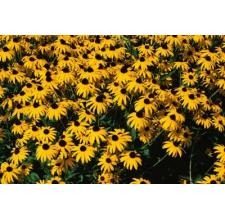Black-eyed Susan (Rudbeckia spp.) is a perennial wildflower favored for its bright, golden, long-lasting blooms. An easy-to-care-for plant, black-eyed Susan still suffers from a few fungal diseases, notably septoria leaf spot.
Symptoms
-
Septoria leaf spot begins as small, dark brown spots on leaves that grow up to 1/4 inch in diameter. Spots begin to appear in early summer. The disease is disfiguring, but is rarely fatal.
Cause
-
Excessive moisture in the form of rain, irrigation and humidity leads to septoris. The disease spreads by spores, which spread from leaf to leaf as rain or irrigated water splashes upon them.
Prevention
-
Planting black-eyed Susans with enough space for good air circulation minimizes the growth of the fungus. Overhead watering should be avoided to keep the leaves as dry as possible. Removing affected stems at the end of the season reduces spore populations for the next season.
Treatment
-
Fungicides containing copper or chlorothalonil reduce the spread of the disease and protect new growth. Preventive applications of fungicide should begin in late spring, before spots start to appear.
Alternate Diagnosis
-
Other fungal diseases common to rudbeckia are angular leaf spot, Cylindrosporium leaf spot and ramularia leaf spot. All three are similar in appearance to septoria leaf spot and managed the same way.


Deprecated: strpos(): Passing null to parameter #1 ($haystack) of type string is deprecated in /home/agriviek8Qv/agriviet.net/public_html/wp-includes/comment-template.php on line 2522